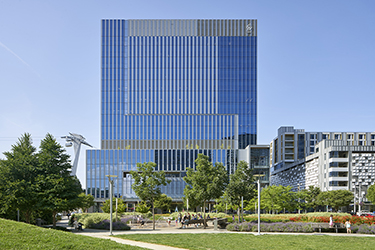|
Subscribe / Renew |
|
|
Contact Us |
|
| ► Subscribe to our Free Weekly Newsletter | |
| home | Welcome, sign in or click here to subscribe. | login |
Construction
| |
 |
July 29, 2021
How flexible design served OHSU during the pandemic
ZGF

Neiger
|
When the coronavirus pandemic spread to the United States in early 2020, Oregon Health & Science University was just beginning to see the benefits of its new Multispecialty Procedural Unit — a three-level, integrated procedural and surgical platform in the Center for Health & Healing Building 2 (CHH2). The 14-story ambulatory tower in Portland houses several multi-specialty clinics, a first-of-its-kind extended stay unit, the Knight Cancer Institute Outpatient Clinic, Infusion & Clinical Trials Unit, a laboratory, pharmacy, phlebotomy services and more.
When CHH2 opened in 2019, the project’s approach to co-locating three similar yet disparate procedural and perioperative services in the MSPU — endoscopy, cardiology and interventional radiology — resulted in a 20% increase in surgical volumes the first year of operations, an improved patient experience, and a new way of working as an integrated care team. What the team wouldn’t realize until later was that the building’s flexible, forward-thinking design would also position OHSU to effectively respond to COVID and enable the MSPU to safely resume full operations in less than two months.
CAMPUS CONTEXT
OHSU is the only academic medical center in Oregon, one of only two designated Level 1 trauma centers in Oregon, and the main tertiary care and referral center for the central West Coast. Like many medical centers in constrained urban areas, OHSU’s acute care and critical care units were consistently at 95% to 98% capacity — or exceeding capacity — limiting its ability to accept high acuity transfers from community hospitals.
With an eye toward the future, OHSU expanded to a previously undeveloped waterfront site just south of the main campus on Marquam Hill. Leadership saw the ZGF-designed CHH2 and Rood Family Pavilion project as an opportunity to move outpatient services from “The Hill,” freeing up space for critical inpatient care on the main campus while providing guest housing for patients and families with access to Marquam Hill via the tram. Doing so would optimize space, efficiency, and improve the patient and staff experience.
A NEW WAY
From the start, shifting patients from The Hill to this new site eliminated a host of issues. But planning and designing it the same way — with each department in their own silo, as they had been previously — was not the solution and required a new way of thinking. During the integrated design process, ZGF used value stream mapping as a tool to identify and visualize the sequence of steps for typical patients and providers. Once the doctors and nurses saw the similarities in what they do and when they do it, they realized the possibilities of coming together as an integrated unit.
The resulting program stacks the MSPU, clinical support functions and outpatient surgery on levels two, three and four, respectively. These floors have standardized circulation patterns, patient care, and staff spaces to support the same flows on each floor, along with central sterile processing, a clean core and shared elevators.
INITIAL OUTCOMES
Early on, the MSPU team began collecting data to measure how the new space performed against the project goals. They measured patient and staff experience, surgical and procedural volumes, room and staff utilization, and more. This enabled leadership to understand what was working well, identify areas for improvement, and continue pushing the operational approach for the building.
The first year of data showed that from its opening in April 2019 to March 2020 — just before the first COVID surge in Oregon — operating as one integrated unit offered benefits on many levels: improved efficiency by consolidating staffing and resources, enhanced flow and throughput, increased on-time starts and decreased overtime, improved utilization, reduced turnover time, and better patient and staff experience.
Several new MSPU programs and services came online or expanded throughout the year as part of a continuous effort to move complex procedures out of the main campus operating rooms.
BRACE FOR IMPACT
Then, in April 2020, COVID disrupted all OHSU operations. The MSPU faced an operational crisis due to capacity constraints, and all non-urgent and elective procedures were canceled. Meanwhile, the main campus faced a shortage of inpatient beds and risked not being able to meet patient demand in the OR.
Fortunately, CHH2 was granted a temporary license of inpatient waiver to utilize the Overnight Care Unit (OCU) for inpatient use. This resulted in a 20% increase in utilization as inpatient surgical cases from the main campus operating rooms moved to the OCU for recovery.
By May 1, an executive order from the Oregon Health Authority permitted hospitals to gradually resume elective or non-urgent procedures if delay was deemed to cause significant impact on patient health, livelihood, or quality of life, and as long as OHSU met all federal and CDC conditions for reopening, which it did.
KEY TAKEAWAYS
Because of its forward-thinking design, CHH2 was the first OHSU building to ramp back up to 100% operations during the peak of this global crisis. There are many lessons to be learned, but these three takeaways can be applied to other health care projects going forward:
• Adequate space. Simply having more space — that was also better-organized and located near the main campus — was key. CHH2’s large patient care spaces and wide corridors accommodated physical distancing and one-way circulation. Conference rooms and waiting rooms on the main campus were turned into staff lounges, but at CHH2 there was adequate indoor staff spaces and access to outdoor spaces, like balconies, for fresh air and respite.
• Built-in flexibility. All-private pre- and post-procedural rooms enabled higher volumes once capacity constraints eased. Caregiver “perches” and windows into patient rooms allowed for observation with minimal direct contact. Utilizing the Overnight Care Unit for inpatient surgery recovery also helped address a lack of beds on the main campus.
• Standardization. Standardized processes and protocols in the MSPU ensured patient and staff safety while maintaining efficiency, volume and growth. Staff were comforted in knowing that CHH2 was a COVID-free environment because every patient getting a procedure was tested, and if they were positive or inconclusive, they were rescheduled.
While it’s difficult to say that what worked in one pandemic will work the same way during future ones, there’s one thing to be sure of: the value of flexibility cannot be overstated. Nor can we truly gauge the efficacy of health care facilities we are entrusted to design and build without careful measurement and verification.
Solvei Neiger is a partner at ZGF Architects leading the firm’s health care practice.
Other Stories:
- Aggregation will drive a new hybrid science space
- Alternative delivery benefits health care in Washington
- Next-gen health care: Building healthier communities, economies
- Micro hospitals offer the right prescription
- The shape-shifting needs of the health care industry
- Best practices in health care development and delivery
- The shifting need for design in health care services
- Evidence-based design improves dialysis treatment experience
- Compounding pharmacies provide community resource



